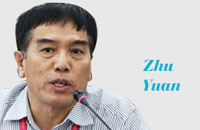Internationalization of renminbi
By Chen Yulu (China Daily) Updated: 2012-03-26 08:07
Three-phase process over the next 30 years will support sustainable development and promote multi-currency system
One of the policy suggestions that Renmin University of China has proposed to the central government is internationalization of the rennminbi.
The internationalization degree of the Chinese currency between the 2030s to the 2040s should be elevated to 20 percent from the present 0.41 percent. This would ensure that in two or three decades the international monetary system would no longer be dominated by the US dollar but would assume a ternary structure comprising the dollar, euro and renminbi.
The internationalization process should be steady and in three phases over the next 30 years.
China should mainly focus on the international settlement function of the renminbi during the first decade and then in the next decade upgrade the renminbi's function as an invoicing currency for financial transactions, followed by realizing renminbi reserves the decade after. During the past year, renminbi settlement of cross-border trade has expanded to the whole nation and reached a total volume of 209 million renminbi ($33.2 million) in 2011, just over three times the volume in 2010. Meanwhile, China has officially launched option trading of foreign exchange, which means the fundamental system of derivatives of the renminbi's exchange rate has been established, with business expanding by 50 percent. Nigeria integrated the renminbi into its foreign exchange reserve system in 2011 and the Hong Kong Special Administrative Region has become an offshore trading center of renminbi pricing since 2009.
Though the speed of the renminbi's internationalization has seemingly increased 20-fold from 0.02 percent in 2010, to 0.41 percent in 2011, it still has a long way to go compared with the euro's internationalization of 35 percent and dollar's 54 percent.
The first problem that must be solved to further internationalize the renminbi is its free convertibility. It took Japan 16 years to achieve this for its currency, 18 years for the United Kingdom and 20 years for Russia. However, it should be possible for China to realize this sometime between 2016 and 2020. If China can accomplish the construction of an innovative country in 2020, free convertibility of the renminbi would have a firm technological, industrial and management infrastructure after its internationalization.
Another challenge is steady and sustainable appreciation of the renminbi. However, as one of the world's manufacturing centers, China is currently at the middle or low end of the global production system and mainly has trade deficits with neighboring Asian countries and trade surpluses with developed countries. If the renminbi is used for settlement with neighboring countries while the dollar and euro are still used for developed countries in the coming decade, during which the Chinese currency will mostly appreciate, our debt to Asian countries will become heavier while our creditor's right against developed countries would suffer.
China is likely to create a fourth-decade of rapid growth, something no modern or contemporary country has ever managed. If China's economic growth surpasses that of the US at an average annual rate of 5 percent and the appreciation of the renminbi continues at an annual rate of 2-3 percent, it is estimated that China will have the world's largest GDP by 2025. It would be sometime after 2030 that the renminbi would almost be on a par with the dollar as a core currency.
The renminbi's internationalization, a symbol of China's rise and national rejuvenation, would not only be a vehicle for both its hard and soft power, it would also provide strong support for the country's sustainable prosperity.
The key is how to achieve the transition of China's economic development pattern on schedule in 2012. The US has built an effective development pattern on the three major pillars of legislation, technology and its financial sector. Faced with similar tasks, China's social elites and the masses should learn from the US experience and unite as one to build our own core value system and successfully accomplish our transition on such a basis.
The author is the president of Renmin University of China.
(China Daily 03/26/2012 page8)











